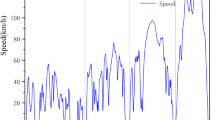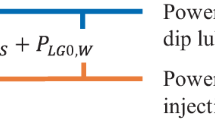Abstract
A new experimental system was developed to measure the cumulative injected fuel mass (CIFM) according to the driving time during the operation of a gasoline injector in an actual vehicle driving condition. An algorithm was developed to calculate the fuel injection timing and injection duration based on engine speed, crank position, and intake air mass data. The intake air mass and engine speed under the vehicle driving conditions were simulated using a computer. In this study, phase I of the FTP-75 mode was used as the vehicle driving mode. GT-Suite® was used as the computer simulation software. The engine part load data, an automatic transmission shift map, torque converter data and various vehicle specifications were used as input data for the GT-Suite® simulation. The computer simulation time interval is 0.05 seconds. An injector drive signal corresponding to the fuel injection amount and timing calculated by the developed algorithm was generated in a FPGA DAQ system. The drive signal from the FPGA DAQ is supplied to the base terminal of the transistor to switch the injector drive voltage source to control the fuel injection. The real-time measurement of the CIFM was done using load cells, dynamic strain amplifiers, and the FPGA DAQ system. The CIFM was measured at intervals of 0.05 seconds using an experimental apparatus developed when the vehicle was driven in the FTP-75 mode. A low-pass filter was used to remove the noise due to the impact force of the fuel jet on the load cell when measuring the CIFM. Twenty-eight repetitive measurements were conducted for an uncertainty analysis of the measurement data. A normal distribution was used as the error function. The deviation % distribution from the average CIFM value was evaluated at the 95 % confidence level. The deviation % from the average CIFM value was 3 % at 50 seconds after the start of phase I of the FTP-75 mode and converged to 0.2 % at 512 seconds.
Similar content being viewed by others
References
S. Jiang, M. Smith, S. Furukawa and M. Menge, Setup of an engine rapid control prototyping system for catalyst research and evaluation testing, SAE paper 2008-01-0286 (2008).
S. Kubota, K. Tanaka and M. Konno, Effect of relative positions of air-fuel mixture distribution and ignition on combustion variation in gasoline engine, SAE paper 2014-01-2629 (2014).
Z. Peng, H. Zhao and N. Ladommatos, Effects of air/fuel ratios and EGR rates on HCCI combustion of n-heptane, a diesel type fuel, SAE paper 2003-01-0747 (2003).
M. Matsui, T. Suzuki and K. Nishio, Fit control for utility engine, SAE paper 1999-01-3320 (1999).
K. Ronald, Automotive Electronics Handbook, McGraw Hill Inc. (1995).
SAE International in United States, Low pressure gasoline injector, Ground Vehicle Standard, J1832-201610 (2016).
Robert Bosch GmbH, Bosch Automotive Handbook, 7th Ed., John Wiley & Sons (2007).
W. Bosch, The fuel rate indicator: A new measuring instrument for display of the characteristics of individual injection, SAE Paper 660749 (1966).
W. Zeuch, New methods for measuring the law of injection and the regularity of injection of diesel injection pumps, MZT, 22 (9) (1961).
M. Marčič, Measuring the injection rate in diesel multi-hole nozzles, SAE Paper 901670 (1990).
L. Postrioti, G. Caponeri, G. Buitoni and N. V. Vuuren, Experimental assessment of a novel instrument for the injection rate measurement of port fuel injectors in realistic operating conditions, SAE Paper 2017-01-0830 (2017).
S. K. Cho and C. H. Lee, A cumulative injected fuel mass measurement under a vehicle driven condition using loadcells, Journal of Ilass-Korea, 21 (1) (2016) 1–6.
EPA, EPA Federal Test Procedure (FTP), https://www.epa.gov/emission-standards-reference-guide/epa-federal-test-procedure-ftp.
Y. Singh, S. Tripathi and M. Pandey, Analysis of digital IIR filter with LabVIEW, International Journal of Computer Applications, 10 (6) (2010).
Acknowledgments
This study was supported by the Research Program funded by the Seoul National University of Science and Technology.
Author information
Authors and Affiliations
Corresponding author
Additional information
Jae-Bum Kim received his B.S. (2018) in Department of Mechanical and Automotive Engineering at Seoul National University of Science and Technology. He has worked in Hyundai Transys Co. Ltd since 2018. His research interests are control of fuel injection system in engines and NVH in powertrain system.
Choong-Hoon Lee received his B.S. (1985), M.S. (1987), and Ph.D. degrees (1996) in Mechanical Engineering from Seoul National University. He worked as a diesel engine development engineer for Daewoo Heavy Industry for six years. He was a visiting research fellow at the Engine Research Center at the University of Wisconsin-Madison in 1997. He has worked in the Department of Mechanical and Automotive Engineering at Seoul National University of Science and Technology as a Professor since 2000. His research interests are the measurement and control of sprays and flows.
Rights and permissions
About this article
Cite this article
Kim, J.B., Lee, C.H. Fuel injection characteristic measurements under a transient injector driving condition using an injector driving algorithm. J Mech Sci Technol 34, 3889–3895 (2020). https://doi.org/10.1007/s12206-020-0839-3
Received:
Revised:
Accepted:
Published:
Issue Date:
DOI: https://doi.org/10.1007/s12206-020-0839-3




